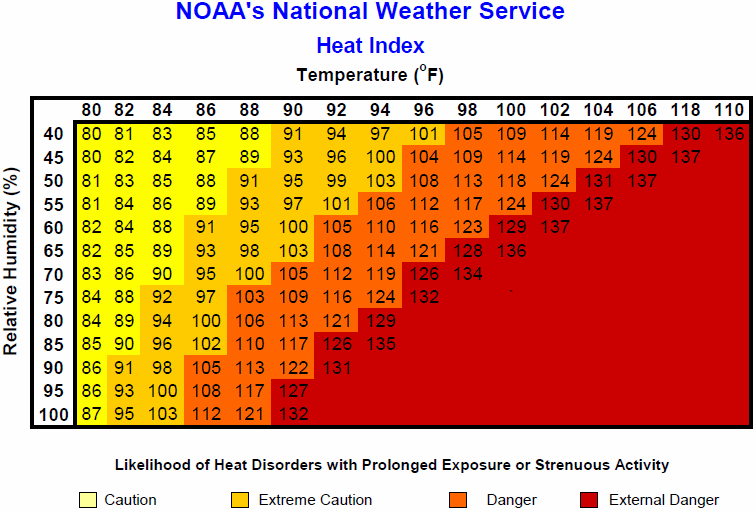Tom is a forty-five-year-old carpenter working on a new apartment building somewhere in the Central Valley of California. He’s been in construction for over twenty years and has seen and done it all.
The Foreman, Jose, stops to chat after lunch and notices Tom looks flushed and sweaty, and he seems to be staring off into space. “Why don’t you get a drink and cool down for a while, man?” Tom smiles and says, “I’ve got to finish framing up that section on the third floor. I’ll drink some water. I’m fine.”
An hour later Jose gets a call that Tom was found unconscious and barely breathing and had to be transported to the hospital by ambulance. Later, the hospital said Tom’s internal body temperature had risen to almost 104 degrees.

According to the Bureau of Labor Statistics Data, “Exposure to environmental heat led to 37 work-related deaths and 2,830 non-fatal occupational injuries and illnesses involving days away from work in 2015. 33 of the 37 fatal work injuries caused by exposure to environmental heat occurred in the summer months of June through September.” And it’s safe to assume that these numbers are highly understated because the majority of heat-related illnesses do not escalate to the point where they require advanced medical care—most are self-treated and likely not recorded on OSHA 300 logs.
Currently, Federal OSHA does not have a specific Heat Illness Prevention regulation. It enforces employer compliance in this area using the General Duty Clause; i.e. Section 5(a)(1) of the Occupational Safety and Health Act (OSHA) of 1970. The General Duty Clause states that “Employers are required to provide their employees with a place of employment that: …is free from recognizable hazards that are causing or likely to cause death or serious harm to employees.”
Only California has a worker heat safety standard that sets compliance requirements for employers in the following industries: agriculture, construction, landscaping, oil and gas extraction, and transportation (with some exclusions). The California regulations are contained in Title 8 CCR §3395, and may become the benchmark for other state plans and Federal OSHA to emulate in the future.
For the purpose of this article, we will discuss the California regulations as an example of the “best management practice” for avoiding heat-related injuries in the workplace. Employers who try to comply with the CA standards are unlikely to be cited under the General Duty Clause in other jurisdictions.
So how does a small company comply, and what does compliance look like?
California OSHA declared a “Special Emphasis Program for heat illness prevention” in 2015 and performed over 3,500 site inspections. They wrote citations at 915 work sites and found the following areas of concern:
- Lack of or an inadequate written Heat Illness Prevention Program
- Lack of or inadequate Provision of Water
- Lack of or inadequate training (employee and supervisor)
We will describe what is required and make some suggestions on how to avoid the three citations above, and also talk about how to determine if there is a risk to workers using the heat index method.
A compliant written Heat Illness Prevention Plan has to be produced for each specific scope of work and job location—a “boilerplate” or one-size-fits-all plan will not pass muster with OSHA, although some elements of the plan can be in the company’s IIPP (CA only). The document also needs to be in English and languages spoken by the majority of workers on the job. It should contain at least the following information:
- Detailed work description
- Phases of the job
- Work durations
- Heat load put on employees: (i.e. required PPE, equipment, etc.)
- Acclimatization procedures
- Water provisions and shade locations
- Training plan: employee and supervisory
- High-heat procedures (>= 950F)
- Emergency services (emergency numbers, nearest hospital location, etc.)
Copies of the written Heat Illness Prevention Plan should be at the job site and available to workers and compliance officers upon request.
A good written plan is not enough
The employer really shows compliance by demonstrating how much and what quality of water and shade are available, attention to acclimatization and rest break policies, and the level of knowledge about heat hazards among supervisors and workers.
For example, a compliance officer entering a job site will be looking for water sources that are:
- “fresh, pure, suitably cool, and provided to employees free of charge” and
- “located as close as practicable to the areas where employees are working”
On multi-story construction sites, water must be provided at least on each floor, and multiple stations will be needed on very large structures. Stations should have clean, cool water in single-use cups.
Beyond providing suitable water, provisions must be in place to ensure adequate supply and that water containers are kept in a sanitary condition. Procedures for ensuring dispensing containers are sanitary should be documented and can include:
- Manufacturer recommended cleaning procedures
- Disinfecting means: soap, baking soda, bleach, frequency
- Designated person(s) responsible for ensuring water containers are kept full and in a sanitary condition
Making sure the program actually works
The effectiveness of any Heat Illness Prevention Program in the field depends on the level of knowledge about heat risks and signs and symptoms of heat illness among supervisors and workers. It’s critical that each employee exposed to heat hazards understands how his or her body reacts to high heat stress and is aware of their own water consumption and workload to avoid experiencing heat illness. Hence the training should include, and compliance officers are likely to ask:
For Workers:
- How to recognize the signs and symptoms of heat illness?
- Have workers been trained to:
- drink water and/or electrolyte beverages frequently?
- rest in the shade as needed?
- look out for one another and immediately report any symptoms?
- Are all employees and supervisors trained on the emergency response procedures and know how to report an accident or medical condition?
For Supervisors:
- Are there procedures to account for the whereabouts of employees at intervals during the shift and at the end of the shift?
- How do you ensure that no employee will be sent home or left unattended without medical assessment if they show signs of heat illness?
- How do you actively watch for signs/symptoms of heat illness in your employees?
- Do supervisors allow workers time to get used to the heat (acclimate)?
How hot is too hot?
The Summer season is usually the best for construction, especially in parts of the country with severe winters. So it’s natural to want to take advantage of longer daylight hours to increase productivity. To avoid heat related illness, the employer needs to monitor the “heat index”. The National Weather Service defines this as: “The heat index, also known as the apparent temperature, is what the temperature feels like to the human body when relative humidity is combined with the air temperature.” High temperatures and high humidity reduce a person’s ability to perspire and efficiently remove heat from the body. See the Heat Index Chart Below (Ref. https://www.weather.gov/ama/heatindex )

The heat index is published by local weather services or available on certain apps. (Search for the “OSHA-NIOSH Heat safety Tool” wherever you download your apps.)
Federal OSHA publishes a simple table relating heat index to health risks and protective measures. (91 degrees F to 103 degrees F is “Moderate” and additional precautions and awareness is suggested.
When the outside temperature exceeds 80 degrees F, California requires employers to provide shade on job sites and high heat procedures to be put in place at 95 degrees F regardless of the heat index.
Tom’s foreman learned the hard way that if a heat illness is suspected, asking someone if they are okay is not enough. Studies show that most people in that situation understate or deny feeling the onset of heat illness. The obvious signs of impending heat stress/exhaustion are symptoms such as high body temperature, redness, profuse sweating, dizziness, and irritability. A person with heat illness may start stumbling or appear less coordinated than usual. Ask the person if she or he has a headache, nausea, or dizziness. Talk to them about a variety of topics to see if they exhibit symptoms of confusion or unusual peevishness.
If you suspect a person is having a problem with the heat, err on the side of caution and insist they stop working, move into the shade or a cooling room, and monitor them closely. Have them drink water or a sports drink and spray their body with cold water or rub them down with ice or a cold cloth. If they don’t cool down quickly, seek medical care.
